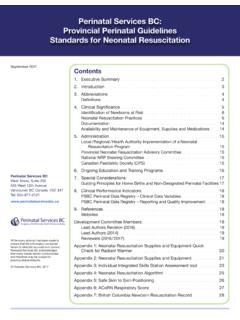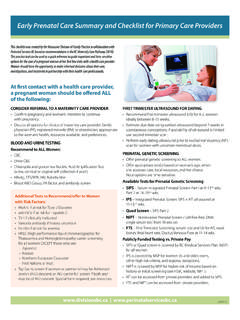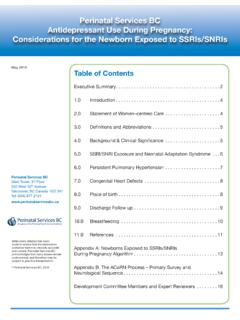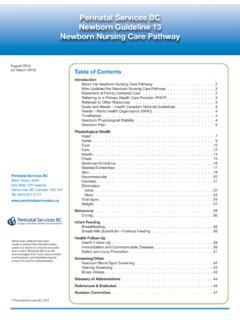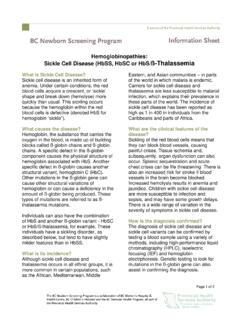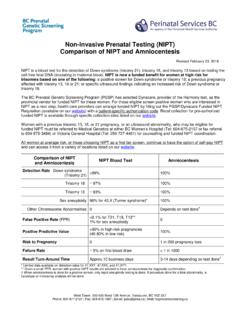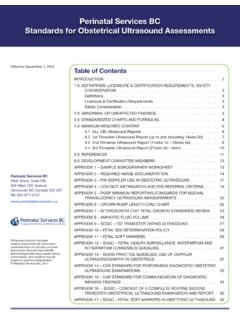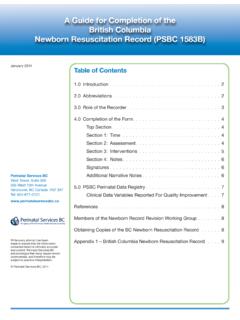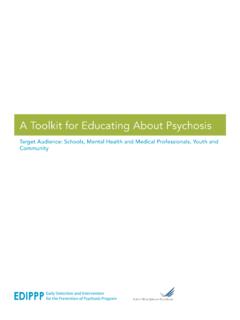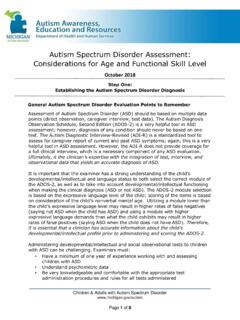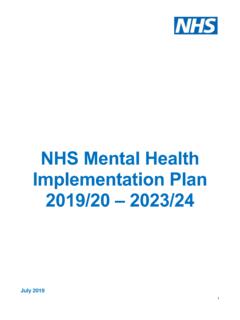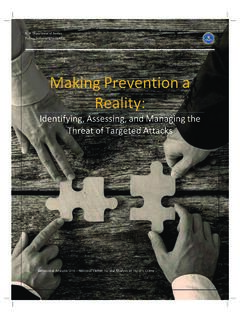Transcription of BCPHP Obstetric Guideline 19 MATERNITY CARE PATHWAY
1 February Perinatal Health Program F502 4500 Oak Street Vancouver, BC Canada V6H 3N1 Tel: (604) 875-3737www. The BC MATERNITY care PathwayWhile every attempt has been made to ensure that the information contained herein is clinically accurate and current, the BC Perinatal Health Program acknowledges that many issues remain controversial, and therefore may be subject to practice interpretation. ContentsStatement of Women-Centered Services .. 2 Statement of Woman-Centered care .. 2 Guiding Principles for care of Pregnant Women .. 3 Women Who May Need Additional care .. 4 Preconception .. 5 Routine Pregnancy care Schedule A.
2 early prenatal care 0 14 weeks .. 6 B. Routine prenatal care at each appointment .. 11 C. 15 20 weeks .. 12 D. 20 27 weeks .. 13 E. 28 36 weeks .. 13 F. 37 41 weeks .. 15 G. 41+ weeks .. 15 Procedures / interventions Not Routinely Recommended .. 16 Lifestyle Advice .. 16 Additional Web Resources .. 21 The Development Committee .. 22 References .. 22 This Guideline is intended as a reference for best practice for routine prenatal care for all women in BC. It was developed in response to recommendations of the BC MATERNITY care Enhancement Project (2004). This project called for the development of a woman-centered PATHWAY to outline the care that a woman can expect to receive at each stage of her purpose of the PATHWAY is to inform all care providers of the current evidence-based recommendations for routine care in pregnancy to ensure that all women in BC receive the same high standard of care regardless of their residence or service provider or special needs.
3 The Guideline is intended for use by physicians, midwives, nurses and other healthcare professionals who care for pregnant women. This document does not include guidelines for additional care that some women overarching philosophy represented in this Guideline is that pregnancy is a normal physiological process and therefore any interventions offered should have known benefits and be acceptable to pregnant women. A companion booklet, Women s Health: Pregnancy Passport, has been developed for pregnant women. The Women s Health: Pregnancy Passport provides women with the same best practice information about the care she can expect to receive during pregnancy, birth, and the early postpartum period.
4 The aim is to support women to participate fully in their care in partnership with their care provider(s). The Woman s Health: Pregnancy Passport allows for personal documentation of a woman s visits to her care provider(s) and contains a list of resources for further information. The Woman s Health: Pregnancy Passport complements the book, Baby s Best Chance Parents Handbook of Pregnancy and Baby provided by the Ministry of Healthy Living and Sport BCPHP , 2010 BCPHP Obstetric Guideline 19 MATERNITY care PATHWAY2 British Columbia Perinatal Health ProgramWho Designed this PATHWAY ?The BC Perinatal Health Program ( BCPHP )2 coordinated the development of this document.
5 It represents a consensus opinion, based on best evidence, of an interdisciplinary team of BC healthcare professionals. The team included family physicians, midwives, obstetricians, acute care and public health nurses, clinical experts from the six BC Health Authorities and representatives of the Ministry of Healthy Living and Sport. The team wants to acknowledge the invaluable assistance they received by referring to a body of work produced by the UK National Institute for Health and Clinical Excellence (NICE).3 The quality of the recommendations in this Guideline has been determined using the criteria described by The Canadian Task Force on Preventive Health care (Table 1).
6 4 Table 1 Levels of recommendations*Recommendation A:There is good evidence to recommend the clinical preventive action Recommendation B:There is fair evidence to recommend the clinical preventive actionRecommendation C:The existing evidence is conflicting and does not allow to make a recommendation for or against use of the clinical preventive action; however, other factors may influence decision-makingRecommendation D:There is fair evidence to recommend against the clinical preventive actionRecommendation I:There is insufficient evidence (in quantity or quality) to make a recommendation; however other factors may influence decision making*Recommendations included in these guidelines have been adapted from the Levels and Quality of Evidence for Treatment Recommendations described in The Canadian Task Force on Preventive Health Care5 Waiver Any procedure or clinical practice described in the Guideline should be applied by the health care provider under appropriate supervision in accordance with professional standards of care .
7 Unique circumstances apply in each practice situation which requires sound clinical judgment. care has been taken to describe generally accepted practices and accurate information as of publication date. However, the authors, editors, and publisher cannot accept any responsibility, and expressly disclaim all liability, including liability for negligence, errors, omissions, or any consequence from application of the information in this Guideline . This Guideline is provided as is, with no warranty, express or implied, with respect to the contents. The information provided in these materials is not a substitute for clinical judgment and should not be construed as clinical every attempt has been made to ensure that the information contained herein is clinically accurate and current as of the publication date, the BCPHP acknowledges that many issues remain controversial, and therefore may be subject to practice interpretation.
8 This guidance represents the view of BCPHP , which was arrived at after careful consideration of the available evidence. The guidance does not override the individual responsibility of healthcare professionals to make decisions appropriate to the circumstances of the individual patient, in consultation with the patient and/or guardian or carer. Statement of Women-Centered Services Women-centred services for MATERNITY care should occur in the context of primary care with the recognition that for the majority of women pregnancy and childbirth are normal life events. The mother and baby are placed at the centre of care , services are planned and provided to meet their needs.
9 Providing women-centred services relies on understanding women s preferences and needs with respect to care . It also involves engaging women and their families (as defined by the woman) as partners in the processes of planning, delivering and evaluating of Woman-Centered CareCore principles of woman-centred care include respect, information sharing, participation and collaboration. Women, their partners and their families should always be treated with kindness, respect and dignity. The views, beliefs and values of the woman and her family in relation to her care and that of her baby should be sought and respected at all times. Women should have the opportunity to make informed decisions about their care and treatment, in partnership with their healthcare 3 Obstetric Guideline 19: MATERNITY care PathwayGuiding Principles for care of Pregnant Women Access: Provide a flexible, diversity-sensitive, high quality, accessible service.
10 Women with limited social or financial means or geographic barriers to access, should be supported through innovative models of prenatal birth: Support and encourage confidence in normal birth and practices that promote minimal choice: Give information about local services and the care provided by family physicians, midwives, and obstetricians, and of where the option of home birth is available. Support women s right to choose her care decision making: Enable women to make informed decisions based on their needs in partnership with their care providers in all aspects of pregnancy and fetal health. Respect and encourage women s own awareness of their health and of the well-being of their fetus.
